
The Waffen-SS was the combat branch of the Nazi Party's Schutzstaffel (SS) organisation. Its formations included men from Nazi Germany, along with volunteers and conscripts from both occupied and unoccupied lands.

The Flemish Legion was a collaborationist military formation recruited among Dutch-speaking volunteers from German-occupied Belgium, notably from Flanders, during World War II. It was formed in the aftermath of the German invasion of the Soviet Union and fought on the Eastern Front in the Waffen SS alongside similar formations from other parts of German-occupied Western Europe.
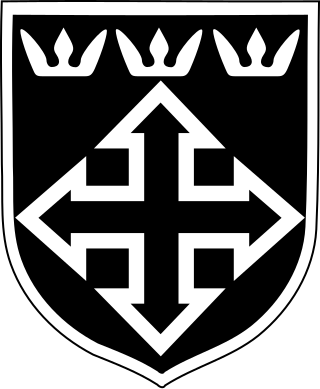
The 26th Waffen Grenadier Division of the SS , was a short-lived infantry division of the Waffen-SS, an armed branch of the German Nazi Party that served alongside but was never formally part of the Wehrmacht during World War II. Established in November 1944 following the German overthrow of the Hungarian regime of Miklós Horthy, it was never properly formed, trained, or equipped, and after being evacuated from its training camp in the face of the advancing Soviet Red Army, it surrendered to the United States Army in Austria in May 1945.

The Dirlewanger Brigade, also known as the SS-Sturmbrigade Dirlewanger (1944), or the 36th Waffen Grenadier Division of the SS, or The Black Hunters, was a unit of the Waffen-SS during World War II. The unit, named after its commander Oskar Dirlewanger, consisted of convicted criminals who were not expected to survive their service with the unit. Originally formed in 1940 and first deployed for counter-insurgency duties against the Polish resistance movement, the brigade saw service in anti-partisan actions in German-occupied Eastern Europe.
The 35th SS- und Police Grenadier Division was an infantry division of the Waffen-SS of Nazi Germany during World War II. It was created from SS-Police units transferred to the Waffen-SS. It was formed in the spring of 1945, and its actual strength is not known. As part of the German Ninth Army, it was badly mauled on the approaches to Berlin during the Battle of the Seelow Heights, and was destroyed during the Battle of Halbe. Various remnants surrendered to American and Soviet forces near the demarcation line of the Elbe.

The Volunteer Legion Netherlands was a collaborationist military formation recruited in the German-occupied Netherlands during World War II. It was formed in the aftermath of the German invasion of the Soviet Union and fought on the Eastern Front in the Waffen SS alongside similar formations from other parts of German-occupied Western Europe. It was the largest Dutch SS unit.
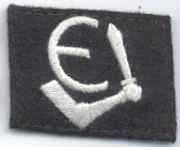
The 20th Waffen Grenadier Division of the SS was a foreign infantry division of the Waffen-SS that served alongside but was never formally part of the Wehrmacht during World War II. According to some sources, the division was under Reichsführer-SS Heinrich Himmler's overall command but was not an integral part of the Schutzstaffel (SS). It was officially activated on 24 January 1944, and many of its soldiers had been members of the Estonian Legion and/or the 3rd Estonian SS Volunteer Brigade, which had been fighting as part of German forces since August 1942 and October 1943 respectively. Both of the preceding formations drew their personnel from German-occupied Estonia. Shortly after its official activation, widespread conscription within Estonia was announced by the German occupying authorities. The division was formed in Estonia around a cadre comprising the 3rd Estonian SS Volunteer Brigade, and was initially known as the 20th Estonian SS Volunteer Division.

The 10th SS Panzer Division "Frundsberg" was a German Waffen-SS armoured division during World War II. The division's first battles were in Ukraine in April 1944. Afterwards, the unit was then transferred to the west, where it fought the Allies in France and at Arnhem. The division was moved to Pomerania, then fought south east of Berlin in the Lusatian area until the end of the war.
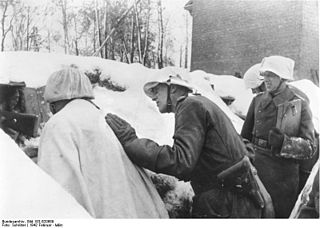
The 18th Army was a World War II field army in the German Wehrmacht.
SS-Standartenführer (Colonel) Hans Wilhelm Kempin was a German Waffen-SS combat and training officer who served in the SS-Standarte Deutschland, SS-Regiment Der Führer and later commanded the 547. Volksgrenadier-Division, 38. SS-Grenadierdivision Nibelungen, 32.SS-Freiwilligen-Grenadier-Division 30.Januar, and the Waffen-SS Unterführerschule in Laibach (Ljubljana).

The 30th Waffen Grenadier Division of the SS(1st Belarusian) was a short-lived German Waffen SS infantry division formed largely from Belarusian, Russian and Ukrainian personnel of the Schutzmannschaft-Brigade Siegling in August 1944 at Warsaw in the General Government. The division was transferred to southeastern France by mid-August 1944 to combat the French Forces of the Interior (FFI). The division's performance in combat was poor, and two battalions mutinied, murdered their German leaders, and defected to the FFI. Other troops of the division crossed the Swiss border and were interned. Afterwards, some of the division's personnel were transferred to the Russian Liberation Army while others were retained to form the SS "White Ruthenian" infantry brigade from January 1945.
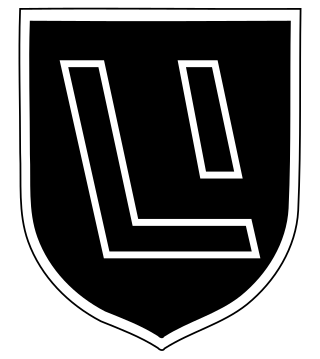
The 15th Waffen Grenadier Division of the SS was an Infantry Division of the Waffen-SS during World War II. It was formed in February 1943, and together with its sister unit, the 19th Waffen Grenadier Division of the SS formed the Latvian Legion.

The 29th Waffen Grenadier Division of the SS also Legione SS Italiana was an SS formation of Nazi Germany during World War II. It was originally created in the puppet Italian Social Republic in 1943 as the Italian Legion, later renamed to a brigade. The unit was upgraded to division status on 10 February 1945.

The Führer Grenadier Brigade was an élite German Army combat unit which saw action during World War II. The Führer Grenadier Brigade is sometimes mistakenly perceived as being a part of the Waffen-SS, whereas it was actually an Army unit and technically assigned to the Großdeutschland Division. This misconception comes from its original duty of guarding Adolf Hitler's East Prussian Wolfsschanze Headquarters, a task which sounded similar to the original one of Waffen-SS 1. Panzer Division "Leibstandarte SS Adolf Hitler", which in turn stemmed from the Führer's original bodyguard corps. Fighting on both the Eastern and Western Fronts, the brigade surrendered to U.S. forces in Austria in 1945.

The 31st SS Volunteer Grenadier Division was a unit of the German armed forces during World War II. It was formed from the Hungarian Volksdeutsche, mostly from the Bačka in September 1944. By November 1944 it was in action on the Hungarian Front.
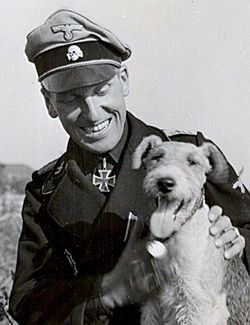
Johannes-Rudolf Mühlenkamp was a Waffen-SS officer and divisional commander during World War II who led SS Division Wiking. He was a recipient of the Knight's Cross of the Iron Cross with Oak Leaves.

The 38th SS-Grenadier-Division "Nibelungen" was a Waffen-SS formation of Nazi Germany during World War II.
The V SS Mountain Corps was a Waffen-SS formation that existed in the later periods of World War II. The corps fought against Yugoslav Partisans in the Balkans as part of the 2nd Panzer Army from October 1943 to December 1944. At this time it rarely had more than two low strength divisions. In 1945, the corps fought on the Oder line as part of the 9th Army, in the Frankfurt am Oder area, and in the Battle of Berlin that followed.

During World War II, the Waffen-SS recruited significant numbers of non-Germans, both as volunteers and conscripts. In total some 500,000 non-Germans and ethnic Germans from outside Germany, mostly from German-occupied Europe, were recruited between 1940 and 1945. The units were under the control of the SS Führungshauptamt beneath Reichsführer-SS Heinrich Himmler. Upon mobilization, the units' tactical control was given to the Oberkommando der Wehrmacht.
The XI SS Corps was a Waffen-SS corps created on July 24, 1944 in southern Poland on the basis of the remains of the headquarters of the defeated V Army Corps and employed on the Eastern Front in 1944-1945 during World War II.
















